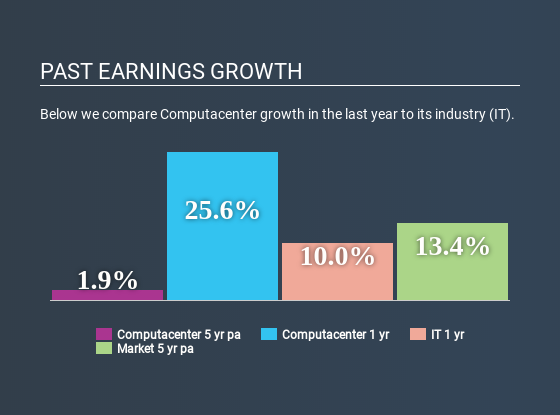Computacenter plc's (LON:CCC) Stock Has Seen Strong Momentum: Does That Call For Deeper Study Of Its Financial Prospects?

Computacenter (LON:CCC) has had a great run on the share market with its stock up by a significant 53% over the last three months. We wonder if and what role the company's financials play in that price change as a company's long-term fundamentals usually dictate market outcomes. Specifically, we decided to study Computacenter's ROE in this article.
Return on equity or ROE is an important factor to be considered by a shareholder because it tells them how effectively their capital is being reinvested. In simpler terms, it measures the profitability of a company in relation to shareholder's equity.
Check out our latest analysis for Computacenter
How Is ROE Calculated?
Return on equity can be calculated by using the formula:
Return on Equity = Net Profit (from continuing operations) ÷ Shareholders' Equity
So, based on the above formula, the ROE for Computacenter is:
21% = UK£102m ÷ UK£492m (Based on the trailing twelve months to December 2019).
The 'return' is the amount earned after tax over the last twelve months. One way to conceptualize this is that for each £1 of shareholders' capital it has, the company made £0.21 in profit.
What Is The Relationship Between ROE And Earnings Growth?
Thus far, we have learnt that ROE measures how efficiently a company is generating its profits. Based on how much of its profits the company chooses to reinvest or "retain", we are then able to evaluate a company's future ability to generate profits. Assuming everything else remains unchanged, the higher the ROE and profit retention, the higher the growth rate of a company compared to companies that don't necessarily bear these characteristics.
Computacenter's Earnings Growth And 21% ROE
To begin with, Computacenter seems to have a respectable ROE. On comparing with the average industry ROE of 16% the company's ROE looks pretty remarkable. Given the circumstances, we can't help but wonder why Computacenter saw little to no growth in the past five years. Based on this, we feel that there might be other reasons which haven't been discussed so far in this article that could be hampering the company's growth. For example, it could be that the company has a high payout ratio or the business has allocated capital poorly, for instance.
We then compared Computacenter's net income growth with the industry and found that the company's growth figure is lower than the average industry growth rate of 26% in the same period, which is a bit concerning.
Earnings growth is a huge factor in stock valuation. It’s important for an investor to know whether the market has priced in the company's expected earnings growth (or decline). By doing so, they will have an idea if the stock is headed into clear blue waters or if swampy waters await. One good indicator of expected earnings growth is the P/E ratio which determines the price the market is willing to pay for a stock based on its earnings prospects. So, you may want to check if Computacenter is trading on a high P/E or a low P/E, relative to its industry.
Is Computacenter Efficiently Re-investing Its Profits?
In spite of a normal three-year median payout ratio of 39% (or a retention ratio of 61%), Computacenter hasn't seen much growth in its earnings. So there could be some other explanation in that regard. For instance, the company's business may be deteriorating.
Our latest analyst data shows that the future payout ratio of the company over the next three years is expected to be approximately 43%. Regardless, Computacenter's ROE is speculated to decline to 15% despite there being no anticipated change in its payout ratio.
Summary
In total, it does look like Computacenter has some positive aspects to its business. Yet, the low earnings growth is a bit concerning, especially given that the company has a high rate of return and is reinvesting ma huge portion of its profits. By the looks of it, there could be some other factors, not necessarily in control of the business, that's preventing growth. With that said, the latest industry analyst forecasts reveal that the company's earnings growth is expected to slow down. Are these analysts expectations based on the broad expectations for the industry, or on the company's fundamentals? Click here to be taken to our analyst's forecasts page for the company.
Love or hate this article? Concerned about the content? Get in touch with us directly. Alternatively, email editorial-team@simplywallst.com.
This article by Simply Wall St is general in nature. It does not constitute a recommendation to buy or sell any stock, and does not take account of your objectives, or your financial situation. We aim to bring you long-term focused analysis driven by fundamental data. Note that our analysis may not factor in the latest price-sensitive company announcements or qualitative material. Simply Wall St has no position in any stocks mentioned. Thank you for reading.

